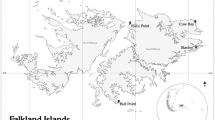Abstract
Mercury concentrations were determined in muscles and feathers of 58 cock pheasants. Birds were collected from seven different polluted sites in southern Poland in 1987. The mercury concentrations in the muscle ranged from 0.010 to 0.026 mug g dry mass. The significantly highest values were found in muscle samples from Przylasek and Przemysl. The levels found in the flight feathers were higher than in breast feathers. Average concentrations in flight feathers ranged from 0.050 mug g (Przemysl) to 0.240 mug g dry mass (Przylasek). © Rapid Science 1998
Similar content being viewed by others
References
Adams WJ, Prince H. 1976 Mercury levels in the tissues of ring-necked pheasants fed two mercurial fungicides. Bull Environ Contam Toxicol 15, 316–335.
Altmeyer M, Dittmann J, Dmowski K, Wagner G, Muller P. 1991 Distribution of elements in flight feathers of a white-tailed eagle. Sci Total Environ 105, 157–164.
Amdur MO, Doull J, Klaassen CD. 1991 Cassarett and Doull's Toxicology. New York, Oxford: Pergamon Press.
Berlin M. 1986 Mercury. In: Friberg L, Nordberg GF, Vouk V, eds. Handbook on Toxicology of Metals, 2nd edn. Amsterdam: Elsevier Science Publisher BV.
Braune BM. 1987 Comparison of total mercury levels in relation to diet and molt for nine species of marine birds. Arch Environ Contam Toxicol 16, 217–224.
Braune BM, Gaskin DE. 1987 Mercury levels in Bonapartes’ Gull (Larus philadelphia) during autumn molt in the Quoddy region, New Brunswick, Canada. Arch Environ Contam Toxicol 16, 539–549.
Burger J, Gochfeld M. 1991 Lead, mercury, and cadmium in feathers of tropical terns in Puerto Rico and Australia. Arch Environ Contam Toxicol 21, 311–315.
Burger J, Gochfeld M. 1992 Trace elements distribution in growing feathers: additional excretion in feather sheaths. Arch Environ Contam Toxicol 23, 105–108.
Burger J, Schreiber EAE, Gochfeld M. 1992 Lead, cadmium, selenium and mercury in seabirds feathers from the tropical mid-Pacific. Environ Toxicol Chem 11, 815–822.
Cosson RP, Amiard JC, Amiard-Triquet C. 1988 Trace elements in little egrets and flamingos of Camargue, France. Ecotoxicol Environ Saf 5, 211–224.
Dittmann J, Altmeyer M, Dmowski K, Kruger J, Muller P, Wagner G. 1990 Mercury concentrations in a white-tailed eagle (Haliaetus albicilla) from the vicinity of Warsaw, Poland. Environmental Conservation 17, 75–77.
Doi R, Ohno H, Harada M. 1984 Mercury in feathers of wild birds from the mercury polluted area along the shore of the Shiranui Sea Japan. Sci Total Environ 40, 155–167.
Eisler R. 1987 Mercury hazards to fish, wildlife, and invertebrates: a synoptic review. US Fish Wildl Serv Biol Rep. 85(1.10).
Fimreite N. 1974 Mercury contamination of aquatic birds in northwestern Ontario. J Wildl Manage 38, 120–131.
Fimreite N, Brevik EM, Torp R. 1982 Mercury and organochlorines in eggs from a Norwegian gannet colony. Bull Environm Contam Toxicol 28, 58–60.
Furness RW, Hutton M. 1980 Pollutants and impaired breeding of Great Skuas Catharacta skua in Britain. Ibis 122, 88–94.
Furness RW, Muirhead SJ, Woodburn M. 1986 Using birds feathers to measure mercury in the environment: Relationship between mercury content and moult. Mar Pollut Bull 17, 27–30.
Gochfeld M, Saliva J, Lessser F, Shukla T, Bertrand D, Burger J. 1991 Effects of color on cadmium and lead levels in avian contour feathers. Arch Environ Contam Toxicol 20, 523–526.
Goede AA, Nygard T, De Bruin M, Steinnes E. 1989 Selenium, mercury, arsenic and cadmium in the lifecycle of the dunlin, Calidris alpina, a migrant wader. Sci Total Environ 78, 205–218.
Hahn E, Hahn K, Stoeppler M. 1993 Bird feathers as bioindicators in areas of the German environmental specimen bank – bioaccumulation of mercury in food chains and exogenous deposition of atmospheric pollution with lead and cadmium. Sci Total Environ 139/140, 259–270.
Hakkinen I, Hasanen E. 1980 Mercury in eggs and nestlings of the osprey (Pandion haliaetus) in Finland and its bioaccumulation from fish. Ann Zool Fennici 17, 131–139.
Honda K, Nasu T, Tatsukawa R. 1986 Seasonal changes in mercury accumulation in the Black-eared Kite, Milvus migrans lineatus. Environ Pollut Ser A 42, 325–334.
King KA, Custer TW, Quinn JS. 1991 Effects of mercury, selenium, and organochlorine contaminants on reproduction of fosters terns and black skimmers nesting in a contaminated Texas Bay. Arch Environ Contamin Toxicol 20, 32–40.
Lewis SA, Furness RW. 1991 Mercury accumulation and excretion in laboratory reared black-headed gull Larus ridibundus chicks. Arch Environ Contam Toxicol 21, 316–320.
Lewis SA, Becker PH, Furness RW. 1993 Mercury levels in eggs, tissues, and feathers of herring gulls Larus argentatus from the German Wadden Sea Coast. Environ Pollut 80, 293–299.
Lodenius M, Kuusela S. 1985 Mercury content in feathers of the kestrel Falco tinnunculus L. in Finland. Ornis Fennica 62, 158–160.
Mukherjee B. 1989 The Release of Cadmium and Mercury into the Finish Environment. Report 64. Ministry of the Environment, Environmental Protection Department.
Ohlendorf HM, Harrison CS. 1986 Mercury, selenium, cadmium and organochlorines in eggs of three Hawaiian seabird species. Environ Pollut Ser B 11, 169–191.
Pilastro A, Congiu L, Tallandini L, Turchetto M. 1993 The use of bird feathers for the monitoring of cadmium pollution. Arch Environ Contam Toxicol 24, 355–358.
Samiullah Y. 1990 Biological monitoring of environmental contaminants: animals. MARC Report 37.
Seńczuk W. 1990 Toksykologia. Warszawa: PZWL.
Solonen T, Lodenius M. 1990 Feathers of birds of prey as indicators of mercury contamination in southern Finland. Holarctic Ecology 13, 229–237.
Thompson DR, Furness RW. 1989 The chemical form of mercury stored in South Atlantic seabirds. Environ Pollut 60, 305–317.
Thompson DR, Furness RW, Barrett RT. 1992a Mercury concentrations in seabirds from colonies in the Northeast Atlantic. Arch Environ Contam Toxicol 23, 282–389.
Thompson DR, Furness RW, Walsh PM. 1992b. Historical changes in mercury concentrations in the marine ecosystem of the north and northeast Atlantic ocean as indicated by seabird feathers. J Appl Ecol 29, 79–84.




